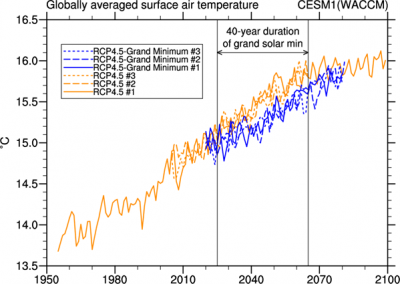Could a Future “Grand Solar Minimum” Like the Maunder Minimum Stop Global Warming?
The Maunder Minimum in the late 17th Century was a roughly 50 year period from about 1650 to 1700 when sunspots vanished, for reasons which are not yet fully understood. It is thought that the decrease in total solar irradiance (TSI) associated with the lower solar activity level contributed to the cooling evident over parts of the earth during the Little Ice Age. Since its cause is unknown, it is possible that the sun could go into another Maunder Minimum-type period of few sunspots and decreased TSI at any time. The question is, if that happened, could we better quantify whether the presumed cooling from a decrease of TSI would be enough to counteract human-caused warming? Here we address that question by introducing a Maunder Minimum-type grand solar minimum into a future climate simulation for the first time using a global coupled climate model with a resolved stratosphere and prognostic ozone chemistry. After the initial decrease of solar radiation in 2020, globally averaged surface air temperature cools relative to the reference simulation by up to several tenths of a degree Centigrade. By the end of the grand solar minimum in 2070, the warming nearly catches up to the reference simulation. Thus, a future grand solar minimum could slow down but not stop global warming.

